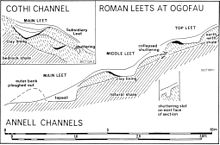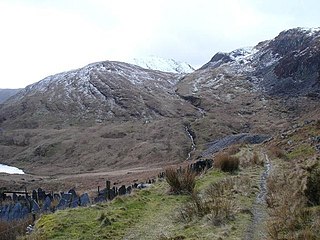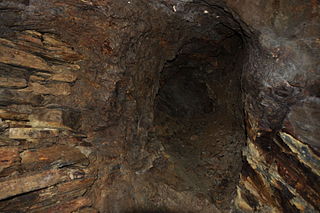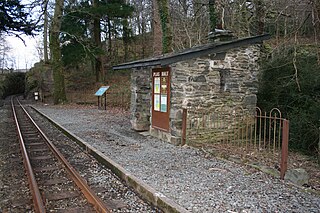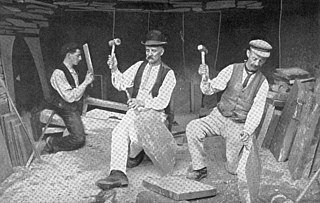Prehistory

Signs of Bronze Age metal extraction have been identified from several locations in the British Isles; this has been certified with carbon-14 analysis. Oliver Davies has accomplished the most intensive archaeological investigation in central Wales at Cwmystwyth. The first investigation conducted in 1935, however in 1986 a group of scientists instituted the Early Mines Research Group and reinvestigate the Copa Hill region including Cwmystwyth. [1] Even though lead deposits are the main concentration the first metal extracted in the area was copper. The main lead lode is at "Comet lode" where a large opencast was excavated. At the walls of the opencast, revealed entrances of tunnels, which were constructed to follow smaller veins. At one of them, a wooden "pipe" was found. Moreover, in the same area a considerable amount of dump was exposed including stone hammers and lead ores. Charcoal samples from the site give several different dates from 2000–1900 BC to 1400 BC. [2]
Other two significant sites are Parys Mountain and Nantyreira mine located in mid-Wales. Copper was the reason for their early exploitation even if Nantyreira's main lode contained predominantly lead ores. S.Timberlake and the Early Mines Research Group in 1986 explored them. The excavations had as a result the discovery of dump in both sites. Charcoal and stonehammers were found inside the tip. The C14 samples place both areas at the Early Bronze Age 2000–1500 BC. [3]
The Great Orme mine exploitation, on the North Wales coast began in the Bronze Age and continued until the nineteenth century. According to remains, mine workings have been traced in the Bryniau, Poethion and Pyllau valley. The dolomitised limestone deposits are rich in copper which early miners must extract mostly by malachite. Because of ground composition, the extraction was sufficiently easy, this explains also the scale of the operations. [4] In 1976 Duncan James revealed in Great Orme a shaft which included a firesetting in connection with stone hammers, bone tools and rock dump. The deposit was placed by radiocarbon-dating to 1395–935 BC. Andy Lewis continued the research in the area at the late 1980s. It is believed that the operations in the location ended shortly after 1000 BC. Extractions techniques with visible remains are the opencasts at the surface and group of caverns and underground shafts. The underground system was accessible by many different openings which simultaneously used as a ventilation system for the tunnels. The tools in the site constitute mainly by pointed bone tools and stonehammers. Other stone tools revealed at the locations were stone mortars and pestles, which indicate another stage in the ores exploitation. Moreover, a unique find for British Isles were the giant hammers. [5]
Evidence for early quarrying was also discovered in Alderley Edge though industrial operations in the 19th century destroyed a big part of the earlier deposits. [6]
Ireland also has many areas related with mining activities from the prehistoric period (O'Brien 2003). However, the two important mines are Mount Gabriel and Ross Island mines. Ross Island lies near Killarney. Inside its area they have been exposed two primitive mines. O'Brien excavate "Danish mines" and revealed a mine cave and a huge spoil concentration nearby thus after the excavation of the latter, another unknown mine also appeared. Furthermore, he investigates pits and dips in the bedrock, which also considered primitive. The feature that differentiates this site is the discovery of a Beaker settlement very close with metallurgical pits, hammers and rock waste. This finds in combination with an early phase in 2400 BC makes the site and the settlement very important for mining Archaeology in the British Isles. [7]
Mount Gabriel located close to west Cork provides useful evidence for the exploitation of copper ore in the Early Bronze Age about 1700 BC. Through research thirty-two areas of activity were underlined. Shallow concaves and significant amount of dump with charcoal and tools are the evidences of Bronze Age copper extraction in the region. Mount Gabriel constitute until now the only locations, where primitive assemblages remained undisturbed by 19th century deeds due to the low quality of its veins. [8]
With the beginning of the Iron Age about 700 BC operations associated with ore exploitations spread around the British Isles. A representative example of the period are Puzzlewood's surface mines. The site prospered especially in the Romano-British period and the late Middle Ages. The limonite ores represent a small part of the local Carboniferous Limestone. The archaeological remains of mining which can be detected in the area are opencasts, known as Scowles Holes. It's important to underline the discovery of habitations areas in close proximity, dated around 100–400 AD. [9]
